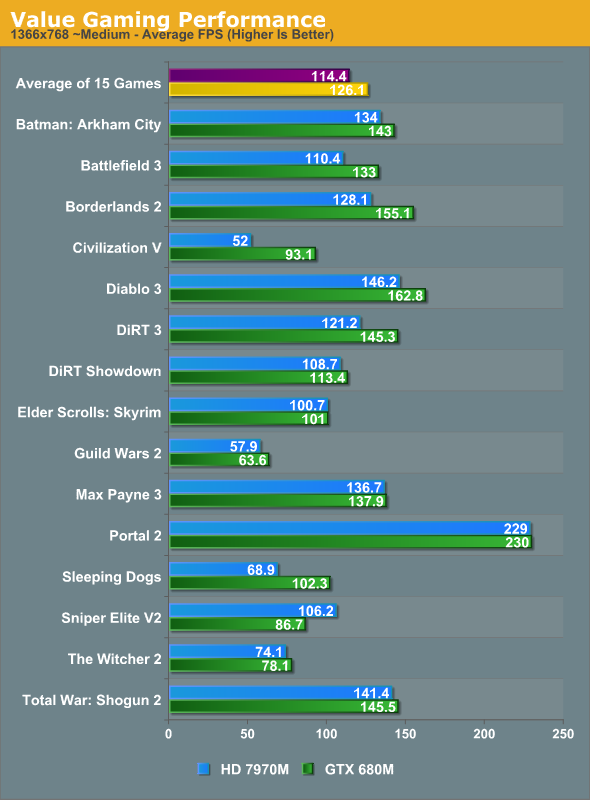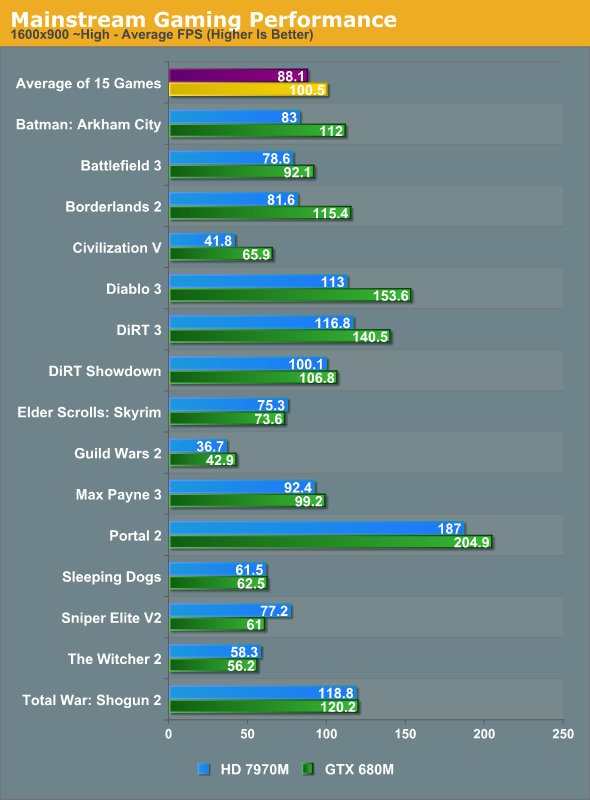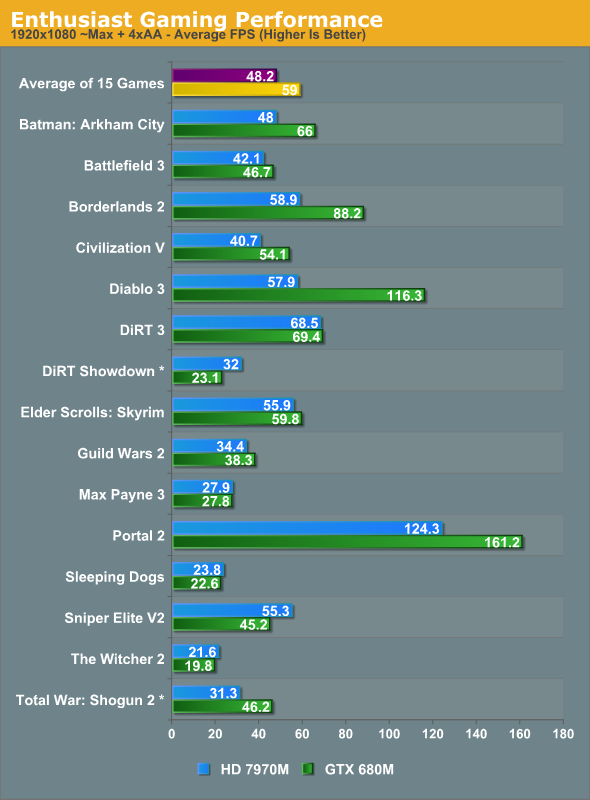AVADirect Clevo P170EM Part 2: GTX 680M Grudge Match
by Jarred Walton on October 15, 2012 6:50 PM ESTGTX 680M vs. HD 7970M – the Big Picture
Our 2012 gaming suite currently ranges in age from over two years old (Civ5) to as recent as 11 months old (Batman), with an average age of around 16 months. Hardware and games have both changed during that time, so we dug through our games folder and added a few other titles to the mix. Okay, truth be told, we actually have quite a few gaming codes from AMD and NVIDIA (as well as Guild Wars 2 from ArenaNet), and we figured a selection of games from both sides should be more or less “fair”. To that end, we’ve benchmarked eight additional games: Borderlands 2 (NVIDIA), Diablo 3 (“agnostic”), DiRT Showdown (AMD), Guild Wars 2 (“agnostic”), Max Payne 3 (NVIDIA), Sleeping Dogs (AMD), Sniper Elite V2 (AMD), and The Witcher 2 (NVIDIA). That’s three NVIDIA “TWIMTBP” (The Way It’s Meant To Be Played) games and three AMD “Gaming Evolved” titles, so overall things should be relatively even. Here’s how the two mobile GPUs stack up using the latest available drivers (NVIDIA 306.97 and an as-yet-unreleased 12.9 Hotfix from AMD), at all three of our target settings.

Not surprisingly, the two GPUs are closest in performance at our Value settings—the CPU becomes more of a bottleneck as we reduce the resolution and details. NVIDIA nearly sweeps the list of games, with Sniper Elite V2 being the sole game where AMD comes out ahead (by a relatively large 22% margin). By the numbers, NVIDIA has a 10% lead in Diablo 3 and Guild Wars 2; a 20% lead in Battlefield 3, Borderlands 2, and DiRT 3; a 50% lead in Sleeping Dogs; and an 80% lead in Civilization V. The remaining seven titles are around 5% or less margin of victory, so they’re basically tied. Overall, NVIDIA ends up with a 10% average performance lead over AMD.

When we move up to our Mainstream settings, the above pattern basically continues. NVIDIA’s overall advantage grows to 14%, with significant leads of 15% or more in Batman: Arkham City, Battlefield 3, Borderlands 2, Civilization V, Diablo 3, DiRT 3, and Guild Wars 2. AMD’s sole major lead continues to be Sniper Elite V2, though they also take a very slight lead in Skyrim and The Witcher 2. If we set the margin to beat at 15%, NVIDIA has seven wins, AMD gets one, and the remaining seven titles are “tied” (within 10%).

At our maximum detail settings, NVIDIA’s average margin of victory increases yet again, this time to 22%. Considering these are the settings most likely to be used with high-end gaming notebooks, the win here is the most meaningful. In terms of ties, there are seven games that are under the 15% margin (Battlefield 3, DiRT 3, Skyrim, Guild Wars 2, Max Payne 3, Sleeping Dogs, and The Witcher 2). Somewhat interesting however is that AMD now manages to come away with four moderate to major wins: DiRT Showdown is a 39% lead and Sniper Elite V2 is a 22% lead for AMD while Sleeping Dogs is a small 5% lead and The Witcher 2 is a 9% lead. The bad news for AMD is that of the remaining titles, NVIDIA comes away with resounding victories in many of them: 38% in Batman, 50% in Borderlands 2 (with the option to enable PhysX still available), 33% in Civilization V, 30% in Portal 2, 48% in Shogun 2, and a resounding 100% lead in Diablo 3.
At the end of the day, however, it’s not just about performance. In the desktop world of gaming PCs, we generally aim for 60FPS or higher as the level we want to reach in order for a game to run “smoothly”. On notebooks, we can’t be quite so demanding, so we have to settle for 30FPS in many cases. Out of our 15 games, at our Enthusiast settings we end up with several that don’t make it into the “playable” range: DiRT Showdown tanks when Global Lighting is enabled, but more so on NVIDIA than on AMD—the 7970M squeaks by with 32FPS while the 680M falls to an unplayable 23FPS. That’s the only title where we’d give one card a pass while the other falls short, but Max Payne 3, Sleeping Dogs, and The Witcher 2 are all too demanding to break 30FPS averages on either GPU. In most cases, dropping the detail settings down a notch (and/or disabling 4xAA—which basically cuts Max Payne 3 performance in half) will fix the problem, but if you were hoping a $2000 gaming notebook would simply take on all contenders without batting a shader core you’re going to be disappointed.
There are also a couple of issues with drivers to report, which we’ve marked with asterisks in the Enthusiast chart. DiRT Showdown refuses to run at 1920x1080 on the 7970M (with the Hotfix drivers), but it works in windowed mode—we tested the 680M in windowed mode as well and found that performance was about 15% lower than in full screen mode, but since this is a driver failure on AMD’s part what we used the higher result for the GTX 680M. (A quick test at 1680x1050 Ultra settings corroborates the margin of victory, regardless.) Second, Shogun 2 as noted earlier refuses to allow the Very High setting on the 7970M, so we tested both GPUs with identical “nearly maxed out” settings, where we used the “High” preset but then enabled all of the extras like Ambient Occlusion, Soft Shadows, etc. And a final note is that both DiRT Showdown and Sniper Elite V2 would crash to the desktop any time we tried to change the resolution within the game on the 7970M; we had to resort to modifying the configuration files directly to set the appropriate resolution.
Overall, NVIDIA clearly wins the performance crown, but we have to wonder how much of this is due to the hardware and how much might be coming from the drivers and developer relations. It’s not too surprising that AMD’s best results are in titles where they’ve apparently lent a hand (DiRT Showdown, Sniper Elite V2, and to a lesser degree Sleeping Dogs), and likewise NVIDIA gets some staggering leads in some of “their” titles. Also of note is that certain older games that were once AMD titles (e.g. Civilization V) now end up running better on NVIDIA GPUs. Is NVIDIA working with the developers after the fact, or optimizing their drivers, or perhaps a little of both? We can’t say for certain, but I do know that I’ve played a lot more games with NVIDIA logos during the boot sequence than games with AMD logos. Developer relations really are key, and titles like Borderlands 2 and Batman are popular offerings that shipped with PhysX support—yet another card in NVIDIA’s hand.










58 Comments
View All Comments
JarredWalton - Tuesday, October 16, 2012 - link
It should be possible, but buying a GTX 680M module on its own can cost $900 or something insane. If anyone has a good link to where you can find just a GPU upgrade for the P170EM, please post. Best I can find right now is on eBay:http://www.ebay.com/itm/CLEVO-X7200-UPGRADE-KIT-NV...
Needless to say, waiting for the Hotfix at this point is reasonable. Barring that, I'd suggest selling your existing system and buying one with GTX 680M rather than just paying for the GPU upgrade.
Wixman666 - Tuesday, October 16, 2012 - link
Don't worry about it.. the difference isn't large enough to upgrade the video or take a bath on selling then buying the other unit.TrantaLocked - Tuesday, October 16, 2012 - link
Great review Jarred!Jamahl - Tuesday, October 16, 2012 - link
Fact is this is a very Nvidia-friendly gaming suite - that's why this site consistently scores as an outlier for Nvidia. As a rule of thumb you want to subtract 10% from the overall result to find the true position of the Nvidia card - true as in what the majority of the tech press find.Even then this particular review is pretty horrible on the 7970, as it has had the best performing games removed (Crysis and Metro). Quite why those are worth removing instead of the complete Nvidia outlier Portal 2 is a mystery (I'm sure we all have our suspicions), but there you go.
JarredWalton - Tuesday, October 16, 2012 - link
You include Crysis and Metro and then suggest our gaming suite needs updating? Give me a break. We removed Crysis as a test game for laptops about two years ago... when Warhead was "only" two years old already. When we revise the gaming suite next time, I'm pretty sure we'll drop Civ5, TWS2, and some of the other games. DiRT 3 was originally an AMD game, but NVIDIA has long since caught up. Civ5 was also an AMD game. Total War: Shogun 2 is an AMD title as well. You see the problem with your assertion that we're "NVIDIA-friendly" yet? So here's the full rundown of the fifteen tested games:Batman: NVIDIA
Battlefield 3: NVIDIA
Borderlands 2: NVIDIA
Civilization V: AMD
Diablo 3: Agnostic
DiRT 3: AMD
DiRT Showdown: AMD
Elder Scrolls Skyrim: Agnostic
Guild Wars 2: Agnostic
Max Payne 3: NVIDIA
Portal 2: Agnostic
Sleeping Dogs: AMD
Sniper Elite V2: AMD
Total War Shogun 2: AMD
Witcher 2: NVIDIA
Final tally:
AMD Titles: Six
NVIDIA Titles: Five
Neutral Titles: Four
The problem you're having is that NVIDIA has generally spent more time and effort optimizing for games, which means that some of the neutral and AMD-sponsored games are now running better on NVIDIA hardware than on AMD. Or maybe you think it's unfair that when we sort alphabetically, NVIDIA titles happen to occupy the first three slots and AMD has three of the last four? Going back to run games that few people are still playing just to try to make things "fair" is actually being the exact opposite. Crysis and Metro? Please. Why not Crysis 2 at least -- oh wait, it's an NVIDIA title.
Brainling - Tuesday, October 16, 2012 - link
Crysis and Metro? Seriously? It's almost 2013, we're four full game cycles away from the release of Metro, and much farther from Crysis.For that matter, my 670 barely breaks a sweat on Metro at 1200p max everything , why would you test a 680 with it? Is it a yawning test to see how bored the graphics card can seem?
silverblue - Friday, October 19, 2012 - link
I don't think it's NVIDIA's fault as a whole that they offer better support than AMD. It's also worth showing games like Portal 2 and DiRT Showdown which have very high framerates because it's interesting to find out why one architecture might monster through them (6xx series) where another might not (7xxx series).I've never actually played Crysis, but from the benchmarks, it looks amazingly inefficient and not a complete representation of what a graphics card can and cannot do.
I used to defend AMD's drivers quite vehemently; after all, they'd never caused me any issues. However, when I see issues with Enduro, poor and non-existent Hybrid Crossfire scaling, GPU underutilisation, slack support for driver command lists, poor video encoding quality... need I go on? AMD could make the best hardware around (and, in reality, it probably does), but what would really benefit them is shifting resources to the software development side. If they're going to be powering two of the next consoles, it's in their best interests to get software support up to scratch. Hardware is all well and good but if the software support isn't completely there...
BiggieShady - Tuesday, October 16, 2012 - link
On the last page, instead of "I’ve beat that horse enough" there should be "I’ve beaten that horse enough". To Beat is an irregular verb - beat, beat, beaten. You should use past participle here - beaten. Or just stop beating the poor horse :)Tijgert - Tuesday, October 16, 2012 - link
For starters the GPU IS upgradeable (see eBay) and over time, with the release of newer GPU's, it will make financial sense to do so. Right now if you can get a great deal on a system with a 7970m you still get the second best performing card in the world with a future upgradeability guarantee (MXM is a standard, not proprietary tech).I think the reasoning of a relative graphics performance increase equal to the total price increase being reasonable or financial sound is something only a teenager or rich madman would swallow.
Given that all the other bits don't increase equally you end up paying a lot for a little.
The screen resolution stays the same, the battery lasts just as long, the CPU doesn't tick any faster, the amount of memory doesn't increase and the Gigs on your SSD don't increase either.
As long as you can get great visuals (even if not at 4xAA and enough detail to see textured zits) at a very playable framerate, you're doing just fine. Just enjoy it and wait for that 690m or 700m or whatever MXM 3.0b card to come out that's better and just upgrade.
FYI I'm on the fence on getting a completely tricked out 2200 euro (yes, euro) system that's three months old for 1560 with a 7970m... or saving for a 680m... see, I'm actually a graphics whore too even if may sound sensible at times...
JarredWalton - Wednesday, October 17, 2012 - link
If a notebook supports the newer GPU with its BIOS/firmware, you can upgrade to a newer GPU. However, just because MXM is a standard doesn't mean all MXM GPUs will work. Take for example the last-generation Clevo notebooks; I'm pretty sure the P150/170HM received the necessary BIOS update to work with 7970M/680M. However, the generation before that AFAIK can't run 7970M/680M. The cards will fit but they don't work properly. As I note below, you can't buy a P1x0EM without a GPU, though, so there's not a real need to compare pricing of just the GPUs. I'm reviewing the P170EM and looking at 7970M vs. 680M, not talking about "should you try to upgrade your older notebook with a 7970M or a 680M?"For your 7970M setup, wait for a week and then maybe we'll know if you should trust AMD's updated drivers.